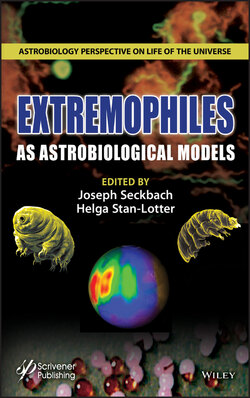Читать книгу EXTREMOPHILES as Astrobiological Models - Группа авторов - Страница 19
1.1 Introduction
ОглавлениеA prominent feature of many, if not most geothermal fields is the presence of abundant fumaroles (i.e., steam vents). These are especially visible early in the day when the cool air condenses the rising water vapor into smoke-like clouds. These geothermal steam vents differ chemically from each other and can be grouped into nonsulfur, sulfur and iron fumaroles [1.1]. A number of different chemical processes cause steam deposits to form and give individual vents their main chemical identities. Fumaroles can issue a greater or lesser volume of steam depending on the meteoric water supply, temperature, size, and type of vent. In turn, steam deposits are caused by condensation of steam on cooler cave or vent walls or surfaces. This allows their collection by sampling of steam cave or vent surfaces at the point of contact between steam and cave surface and yields distinctive chemical-microbiological samples. These samples result from one of the following processes: 1) evaporation of soluble ions leaving deposits of salts or evaporites; 2) oxidation of soluble Fe(II) ions to insoluble precipitates such as iron oxides, hydroxides, or oxyhydroxides; 3) gases like H2S rise with steam, becoming less soluble and form into solid sublimates that are oxidized into sulfur deposits; 4) steam and particulates travel over cave surfaces leading to adhesion or entrapment within the surface matrix; and 5) ammonia forms as vapors rising with steam [1.11] [1.13] and concentrates at the steam deposit site [1.1] comparable to the way H2S acts in acidic systems.
In this study we describe the use of a portable steam collector designed for sterile microbiological sampling to capture volcanic steam and microbial steam vent life forms. Steam exits fumaroles in a continuous flow or in bursts that are both hot and diffuse. This often makes collecting a sufficient quantity of steam vapors for microbiological analysis a challenging prospect. Our collector uses a difference in temperature to condense steam, resulting in hot water guided into a sterile polypropylene collection tube (Figure 1.1). The condenser captures up to 2–3 mL min-1 from vents above 90 °C, making on-site collection a practical procedure. Once we collected steam water samples, we examined the condensed water samples with DNA staining (using DAPI) for microbial life and also established cultures to grow the steam vent microorganisms from locations in Hawai’i, California, New Mexico, Wyoming and Russia. By determining the number of organisms in condensed water samples and the steam flow rate, we were able to estimate the overall fumarole dispersion, as steam vapors exited different types of fumaroles. We concentrated our efforts on the Archaea, a group of organisms known to live at pH and temperature extremes. In some extreme fumaroles, we found these to be the only organisms present. Finally, we sampled both steam and steam cave/vent deposits and found that the deposit matrix formed at the steam-cave surface contact site served as a unique concentrating device to entrap nutrients critical for the survival of specific steam vent organisms. Hawai’i has so far presented the most chemically diverse types of steam vents, making this an ideal site for examining extremophiles and Archaea as a model for life beyond Earth’s boundaries. Other collection sites provide unique steam cave/vent features that increase our understanding of fumarolic microbial life.
Figure 1.1 Steam condenser: (a) Collector body is a stainless cylinder, 1 or 2 liters with overlying funnel condenser and silicone plugged guide rod. Central collection tube holder lies near cylinder bottom. (b) Cutaway diagram showing interior of condenser parts. (c) Condenser has a fitted splash shield to prevent water loss and contamination. Mounting feature (black) allows extension pole or tripod attachment. Operation: Ascending steam contacts underside of cooler cone funnel, transfers heat to water reservoir above, steam condenses to water that drains down funnel to guide rod, and into 50 mL sterile screw cap collection tube. Following collection, sterile tube is capped. (Image credit: the authors).
